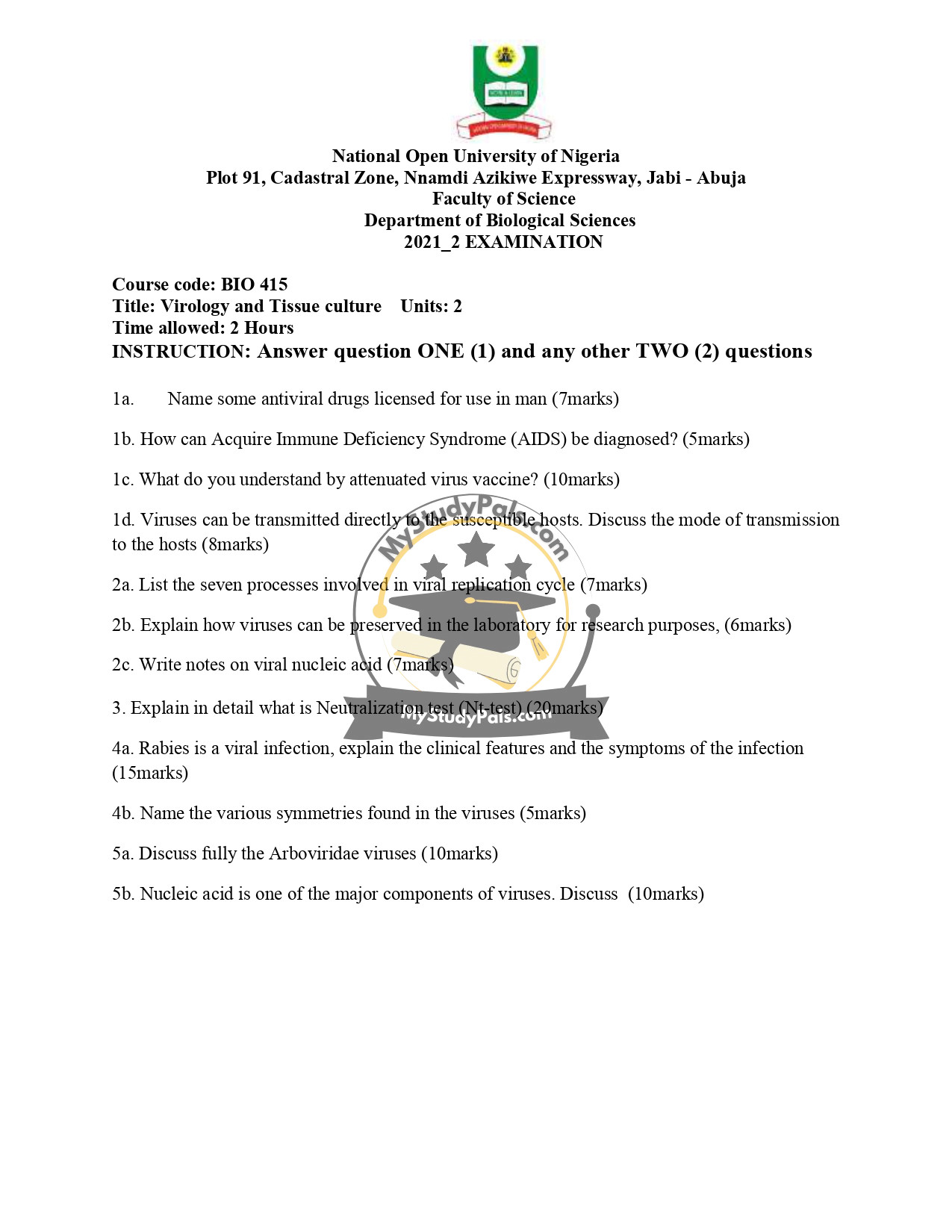ANWSER
Question 1a:
Answer:
Antiviral drugs licensed for use in humans include:
1. Acyclovir (herpes simplex virus).
2. Oseltamivir (Tamiflu; influenza virus).
3. Zidovudine (AZT; HIV).
4. Ribavirin (hepatitis C, RSV).
5. Remdesivir (COVID-19).
6. Tenofovir (HIV, hepatitis B).
7. Ganciclovir (cytomegalovirus).
Question 1b:
Answer:
AIDS is diagnosed through:
1. HIV antibody tests (ELISA as initial screening).
2. Confirmatory tests (Western Blot or PCR for viral RNA).
3. CD4 T-cell count (below 200 cells/mm³ indicates AIDS).
4. Presence of opportunistic infections (e.g., Pneumocystis pneumonia, Kaposi’s sarcoma).
Question 1c:
Answer:
An attenuated virus vaccine contains live viruses weakened to lose pathogenicity but retain immunogenicity. Examples include measles, mumps, rubella (MMR), and oral polio vaccines. Advantages include robust, long-lasting immunity. Risks involve possible reversion to virulence (rare) and contraindication in immunocompromised individuals.
Question 1d:
Answer:
Viral transmission modes:
1. Direct contact (skin-to-skin, sexual).
2. Respiratory droplets (influenza, COVID-19).
3. Blood-borne (HIV, hepatitis B/C via needles).
4. Vertical transmission (mother to fetus, e.g., HIV).
5. Vector-borne (mosquitoes for dengue, Zika).
6. Fecal-oral (norovirus, rotavirus).
7. Zoonotic (animal-to-human, e.g., rabies).
—
Question 2a:
Answer:
Viral replication cycle steps:
1. Attachment/Adsorption.
2. Penetration (entry into host cell).
3. Uncoating (release of viral nucleic acid).
4. Replication (viral genome synthesis).
5. Transcription/Translation (viral protein synthesis).
6. Assembly (packaging components into virions).
7. Release (lysis or budding).
Question 2b:
Answer:
Virus preservation methods:
1. Ultra-low freezing (-80°C or liquid nitrogen).
2. Lyophilization (freeze-drying with stabilizers like sucrose).
3. Cryoprotectants (glycerol or fetal bovine serum to prevent ice damage).
4. Avoid repeated freeze-thaw cycles to maintain viability.
Question 2c:
Answer:
Viral nucleic acids:
– Can be DNA or RNA (never both).
– Single-stranded (ss) or double-stranded (ds).
– Segmented (influenza) or non-segmented.
– RNA viruses: positive-sense (directly translatable) or negative-sense (requires RNA polymerase).
– Retroviruses (HIV) carry reverse transcriptase to convert RNA to DNA.
—
Question 3:
Answer:
Neutralization Test (NT-test):
– Detects virus-specific antibodies by assessing their ability to neutralize viral infectivity.
– Procedure:
1. Mix patient serum (containing antibodies) with a known virus.
2. Inoculate mixture into cell culture or animal model.
3. Observe for cytopathic effects (CPE) or infection.
– Interpretation: Absence of CPE indicates neutralizing antibodies are present.
– Applications: Vaccine efficacy evaluation, immunity assessment, and viral strain identification.
—
Question 4a:
Answer:
Rabies clinical features:
– Prodromal phase: Fever, headache, malaise.
– Acute neurological phase: Anxiety, agitation, hallucinations, hydrophobia (fear of water), aerophobia (fear of air).
– Paralytic phase: Muscle paralysis, coma, and death (nearly 100% fatal post-symptom onset).
Question 4b:
Answer:
Viral symmetries:
1. Icosahedral (e.g., adenovirus).
2. Helical (e.g., rabies virus).
3. Complex (e.g., poxvirus, bacteriophages).
—
Question 5a:
Answer:
Arboviridae (Arthropod-borne viruses):
– Transmitted via arthropod vectors (mosquitoes, ticks).
– Families:
1. Flaviviridae (Dengue, Zika, Yellow Fever).
2. Togaviridae (Chikungunya).
3. Bunyaviridae (Rift Valley Fever).
– Symptoms: Fever, rash, encephalitis, hemorrhagic fever.
– Prevention: Vector control, vaccines (e.g., Yellow Fever vaccine).
Question 5b:
Answer:
Viral nucleic acid:
– Core component carrying genetic information.
– DNA viruses (e.g., Herpesviruses) may integrate into host DNA.
– RNA viruses (e.g., HIV, Influenza) have high mutation rates.
– Genome structure determines replication strategy (e.g., retroviruses use reverse transcription).
– Encodes structural (capsid) and non-structural (enzymes) proteins.


